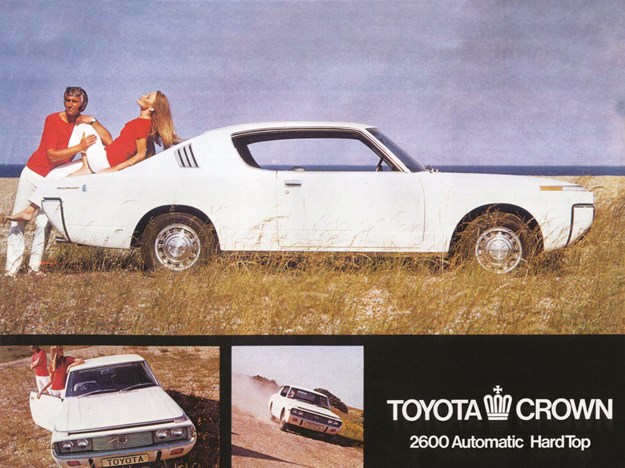Crown Coupe, Charger Time, Hesitating Holden - Mick's Workshop
Mick is toiling away in the workshop and providing you with the car advice you need
.jpeg)
|
|
Very cool visitor – Fiat 500 Giardiniera
|
Tiny Town
You know how some weeks you just seem to get a string of like things happening in a row? For us, if we get one Mustang rolling up for help, you can bet on another couple showing up the same week.
This week it was the turn of the classic mini cars, two of which rolled in as we were doing this column. For a start, we scored a very tasty 1971 Australian-built Mini, aka Morris 1100.
Owned by a young chap called David, it’s been the subject of a detailed and really lovely build over the last couple of years. Guido from Unique Cars mag was in at the time and immediately grabbed the owner and reckons there’s a feature in it.
I had to take it for a brief drive as part of the roadworthy test, which it flew through. And the exercise reminded me just how much fun these cars are. I had a hotted-up one years ago and loved it.
As a restoration target, they’re a great choice as there is a huge knowledge base out there, plus a massive parts-supply industry. Plus, you get a proper fun car at the end of it.
Our next contestant was a Fiat 500 Giardiniera about early 1960s vintage. It’s definitely something you won’t see every day, or not in this country. Like the Mini, these things are a miracle of clever packaging, able to fit mama, papa and the bambinos plus a bit of shopping.
This is a car that appeals to a slightly different group of people, though I wouldn’t be scared of a restoration so long as the body was reasonably sound. They’re pretty simple in the engine department – you’re dealing with an air-cooled twin. Many of the underpinnings are shared with a long line of variants off the Fiat Bambino base, so that side of things is well catered for.
The thing most likely to trip you up is chasing cosmetic parts.
.jpeg) |
| The engine bay in the Mini is a delight. |
Let’s get to my frustration of the week, which is the weird and wonderful difference in standards with interstate registrations. For example, let’s say you’re importing a 1976 BMW as a toy. The process now includes getting a new Australian VIN which must be applied to the car, then you have to run it by a VASS engineer, then through a roadworthy. That’s if you’re in Victoria.
In Queensland, you get the VIN, then a roadworthy and that’s it. Much more straight-forward. If the roadworthy check raises issues, then the person doing it can call for an engineer report.
Surely we could use the Queensland system everywhere.
Crown Coupe
Hi Mick. An elderly family member has admitted to having "just an old car" in his shed, which he’s keen to move on and see someone else get some fun out of it.
I don’t think I’d ever heard of this thing and went to his house for a bit of a look. Under the fairly fragile old tarps was a 1972 Toyota Crown Coupe.
It looks fantastic, and everything I see read about them says they’re pretty rare these days.
It seems to have the 2.6lt six engine and three-speed auto.
We’re not sure how long it is since it last ran – could be one decade or more likely a couple. Maybe more.
So a couple of questions. First I’m tempted to throw some fuel in it and see if it runs, but is there a way of doing this so I don’t do any damage?
Second, it seems to be pretty solid and I reckon it’s worth doing up. What do you think?
Jim Williamsen
Mick says...
That is a magnificent find and whatever it takes to get it back on the road, the car will be worth it. That complex looking two-deck front end was prone to rust where they pressed and stretched the metal. Even sedans are thin on the ground these days.
They were a great car. When they were built, in all honesty they were way ahead of much of what we were building in Australia. The standard packaging included power steering, air-conditioning, push-button radio, lay-back bucket seats – it was all there.
It probably will start. There are things you need to do when it’s been sitting: Get all the fluids out of it, and put in fresh stuff.
At this point, just put in plain water into the cooling system. You can flush it and put the real stuff in later.
Disconnect the fuel system as the lines, pump and tank will be contaminated. You’re better off rigging up a simple way of feeding in fresh fuel to the carby with a hose and a small container.

Pull the sparkplugs, disconnect the coil, and turn it over by hand to check there is nothing nasty happening. Then turn it over on the starter and give it a good run like this.
Once you’re satisfied it’s okay, you can try it with plugs and fuel. It will be likely to leak a little, as some of the seals may be shot. There’s a chance it will start and idle, but don’t rev it.
You will need to go over it replacing hoses, belts and the like, along with a new set of seals through the carburetor.
That 2.6lt six is a great motor. A nice simple overhead-cam engine that’s super strong.
You’ll of course need to go over brakes, bushes, suspension and the like.
No matter, this is a car that’s worth putting serious time and money into. Very few good ones are left around the world and it’s the sort of thing that should get real collector interest if it’s given the lightest possible sympathetic restoration. Good luck with it.
Hesitating Holden
FE Holden with the original engine and three-on-the-tree. It’s a little tired here and there, but it usually runs okay and I like to just use it as it is.
Problem is that it’s been running ragged recently and I can’t seem to get it right. I’ll put the timing light on it and set the points, and all is okay. But then I drive it and it goes okay for a little while then seems to ‘slip’ out of tune. Sure enough when I get it home, the timing is out again.
What am I dealing with here?
Gael Thornbury
Mick says...
For once something that is relatively easy to diagnose from a distance! Your timing gear is past it and needs to be replaced.
It’s not a huge job. The hardest part is getting it back together and making sure the gasket doesn’t leak.
If you’re going to go that far, you should consider putting in a fresh camshaft while you’re on the job. Once they get that tired, they will never stay timed until they’re fixed.
Charger Time
Hey Mick. I have a 770 Charger with the 340 V8 in it.
It’s a bog standard car and I plan to keep it that way – can always jump in something newer if I want to go fast!
First up, what fuel should I be running in it?
And what can I do to sharpen it up a bit, without going down the whole street machine path?
Anders Smith
Mick says...
Most of the 340ci 770s were made for the South Australia police and ‘civilian’ versions were actually pretty rare.
We’re not talking a huge amount of compression, so it should run on 91. However, I’d run it on 95.
By now it will be getting a bit tired. My approach would be don’t waste money on rebuilding cylinder heads. Instead, put them aside (keep them) and buy new alloy heads. A set of Edelbrock units will probably cost less than rebuilding the old iron ones.
You’ve already got the four-barrel manifold, so I’d go alloy heads and a nice camshaft – that will do the job. Replace the timing chain and distributor at the same time.
If it’s running the Carter four-barrel, give it a freshen-up.
XR8 Power
G’day. I’ve been lucky to have an ED XR8 for a fair while now and figure it’s time to cheer it up a little and maybe give it a bit more grunt.
I don’t want to go nuts – no turbo or supercharger, or big blocks. But I reckon there’s room to bring it up to Sprint or GT specs.
Dave Simmons
Mick says...
The ‘hot’ version of that engine had what was called the GT40 heads and you can get current versions of them quite readily as original and aftermarket. Australian firm AFR makes them and they bolt straight on.
You’ll need a cam and solid lifters – keep in mind the GT engine was pulling an extra 500rpm.
They’re fuel injected and there are people out there who can play with the electronic tuning.
Rover Runner
Hi there, Mick. I’ve just bought a 1960 Rover P5, with the 3.0lt inlet-over-exhaust straight six and auto transmission. I love the look and feel of thing and it seemed like a lot of classic car for the money.
It’s running okay and the body seems pretty good – it’s spent most of its time in a dry shed.
So far as I can tell, it’s hardly been used for the last 20 years – maybe started and taken for a quick run around the block once every blue moon.
I’m keen to give it a bit of a birthday and use it a bit more. What should I be doing to get it up to speed for the road?
Ian Ensign
Mick says...
If it’s running, you’re already over by far the biggest hurdle. The best advice is to change all the fluids – oils (engine and transmission), coolant, hydraulic.
Have a good hard look at anything that’s rubber, including the tyres, suspension bushes, hoses and the like. Particularly the brake hoses!
Then just drive it gently and give it a chance to come back to life. Put a couple of hundred kilometres on it and flush the engine and transmission oils again.
They were a big luxurious car back in the day and should be a great thing to play with.
Got a problem?
Want some advice on a build or a potential car purchase? Heck, we’ll even tackle long distance diagnosis. Drop Mick a line at uniquecars@primecreative.com.au
Unique Cars magazine Value Guides
Sell your car for free right here
Get your monthly fix of news, reviews and stories on the greatest cars and minds in the automotive world.
Subscribe

.jpg)










.jpeg)
.jpg)


